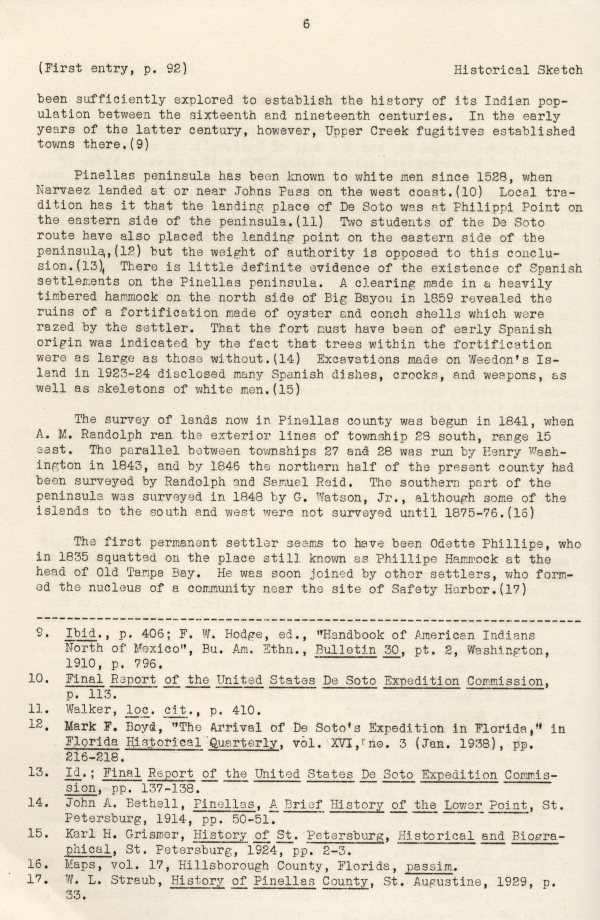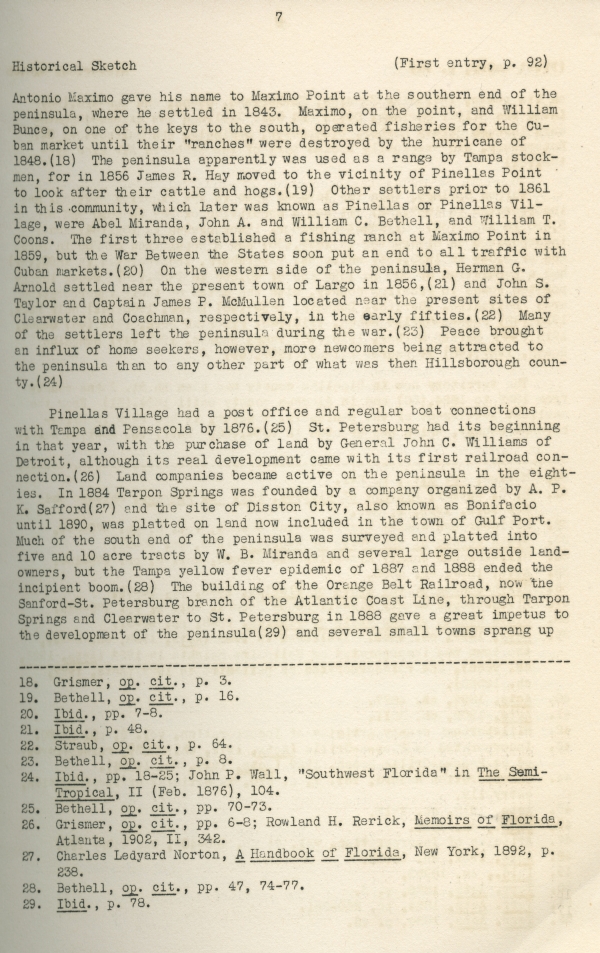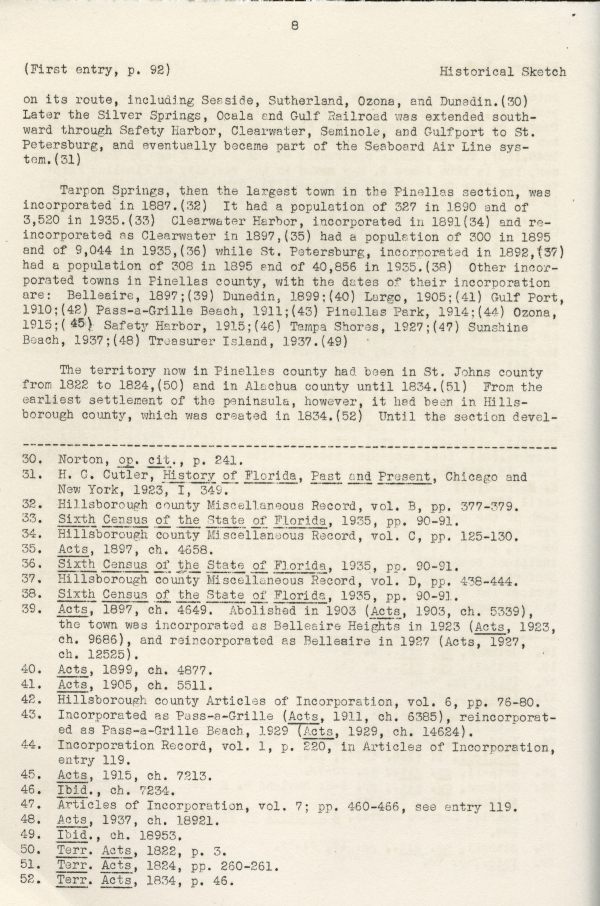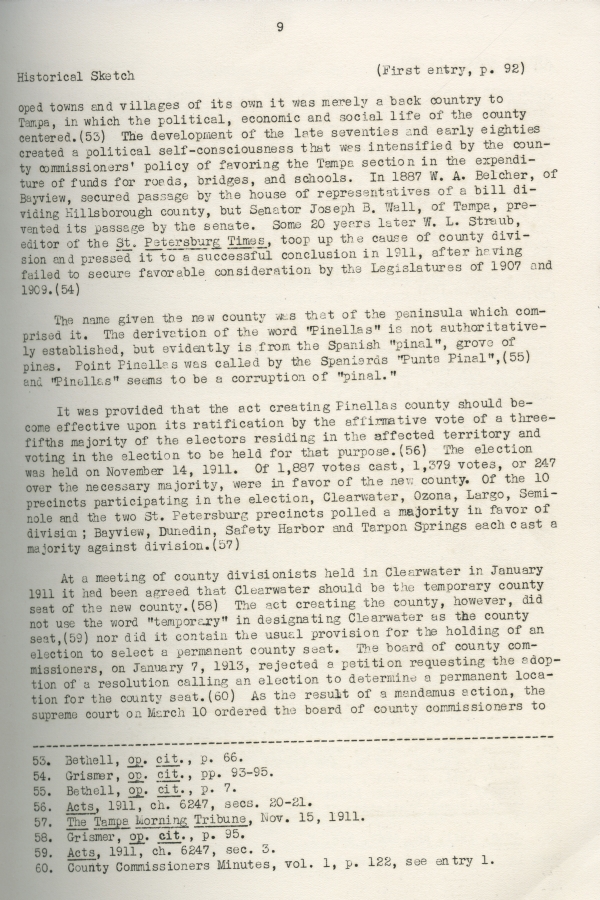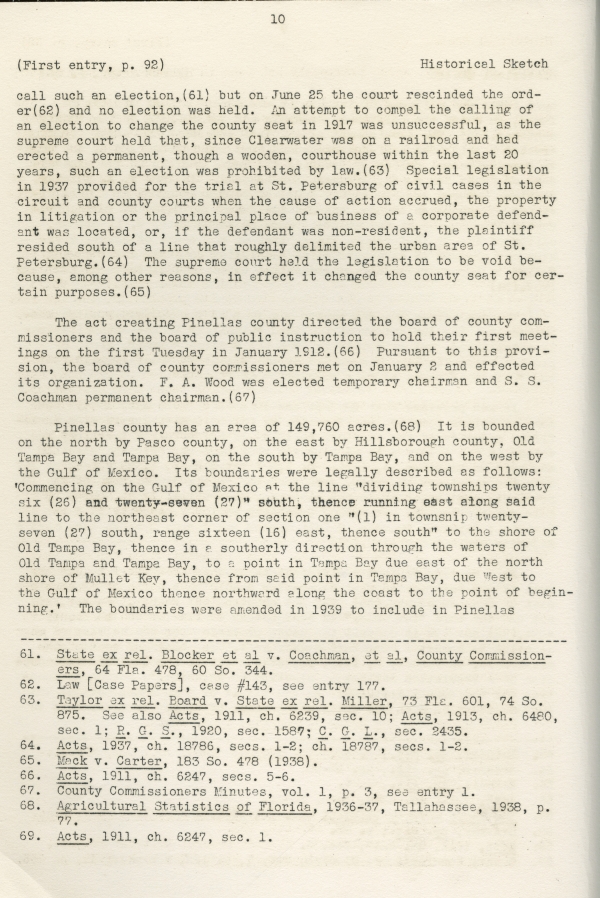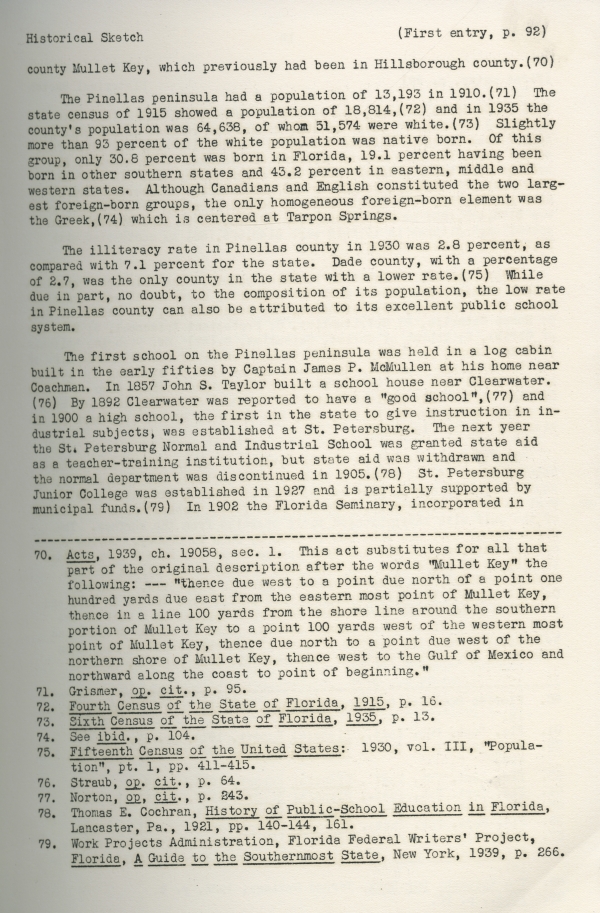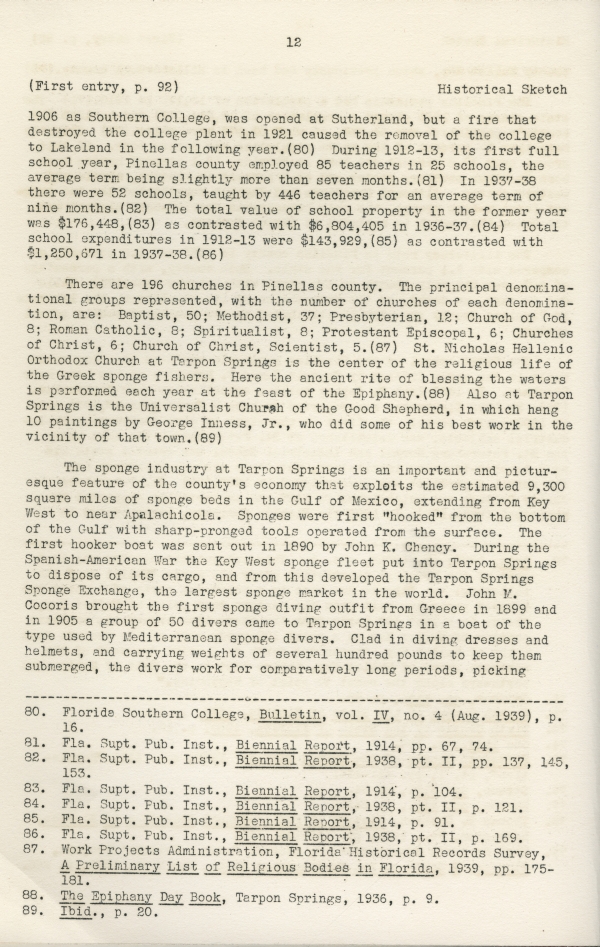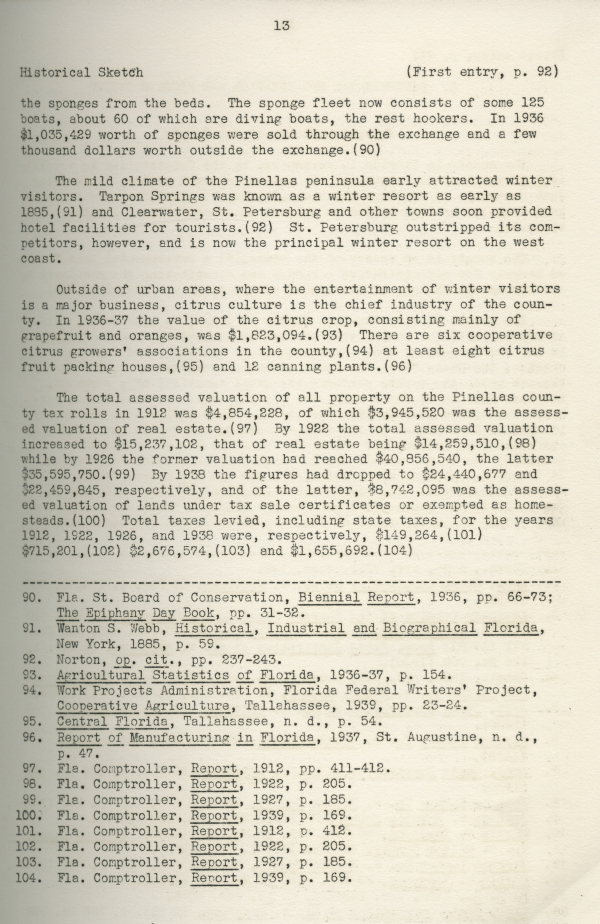Transcript
5
(First entry, p. 92)
1. HISTORICAL SKETCH
Pinellas county occupies the Pinellas peninsula in west central Florida between Tampa Bay and the Gulf of Mexico(1) and includes a narrow chain of barrier-beach islands lying from half a mile to three or four miles off the western shore.(2) The Pinellas mainland is only about 34 miles long and 15 miles wide at its widest point. While the county has a land boundary of only 18 miles, it has a water front of approximately 128 miles. The level and undulating topography of the coastal plain predominates, although rolling or hilly country is found in the northern part of the county.(3) Recorded elevations range from 13 feet at Dunedin on the Gulf coast to 50 feet at Largo, an inland town.(4)
No stream of any importance flows through the county, although the mouth of the Anclote River, a tidewater stream which rises in Pasco county, lies just south of the northern boundary. The best natural drainage is found in the western part of the county, where the "piney woods" or high hammock lands are sufficiently well drained to permit citrus fruit growing and other forms of agriculture. Poorly drained areas lie between Largo and St. Petersburg and extend from Lake Butler southeast to the Hillsborough county line.(5)
The subtropical climate is one of relatively stable temperature, the mean annual temperature being approximately 70 degrees, Fahrenheit, with a winter mean of about 60 degrees and a summer mean of close to 80 degrees. The winter climate is mild and balmy, although killing frosts are not unusual in January and February. The mean annual rainfall is over 50 inches.(6)
The Pinellas peninsula and neighboring keys supported a relatively dense Indian population during the pre-Columbian and early Spanish periods, as evidenced by numerous mounds and shell heaps.(7) Although earlier writers assumed that the Indians around Tampa Bay were Calusa, Swanton has concluded that the tribes in this vicinity belonged to the Timucua group.(8) The archaeological remains on the peninsula have not
-------------------------------------------------------
1. Grove B. Jones and T. M. Morrison, "Soil Survey of Pinellas County Florida," in Fla. St. Geol. Survey, Annual Report, 1915, p. 295.
2. Roland M. Harper, "Geography of Central Florida," in Fla. St. Geol. Survey, Annual Report, 1921, p. 84.
3. Jones and Morrison, loc. cit., pp. 295-296.
4. E. H. Sellards and Herman Gunter, "The Artesian Water Supply of Eastern and Southern Florida," in Fla. St. Geol. Survey, Annual Report, 1913, p. 250.
5. Jones and Morrison, loc. cit., pp. 296, 306.
6. Ibid., pp. 298, 330.
7. See S. T. Walker, "Preliminary Explorations among the Indian Mounds in Southern Florida," Board of Regents, Smithsonian Institution, Annual Report, 1879, pp. 392-413.
8. Final Report of the United States De Soto Expedition Commission, H. Doc. No. 71, 76 Cong., 1 Sess., Washington, 1939, p. 121; John R. Swanton, "Early History of the Creek Indians and Their Neighbors", Bu. Am. Ethn., Bulletin 73, Washington, 1922, p. 331.
6
(First entry, p. 92)
Historical Sketch
been sufficiently explored to establish the history of its Indian population between the sixteenth and nineteenth centuries. In the early years of the latter century, however, Upper Creek fugitives established towns there.(9)
Pinellas peninsula has been known to white men since 1528, when Narvaez landed at or near Johns Pass on the west coast.(10) Local tradition has it that the landing place of De Soto was at Philippi Point on the eastern side of the peninsula.(11) Two students of the De Soto route have also placed the landing point on the eastern side of the peninsula,(12) but the weight of authority is opposed to this conclusion.(13) There is little definite evidence of the existence of Spanish settlements on the Pinellas peninsula. A clearing made in a heavily timbered hammock on the north side of Big Bayou in 1859 revealed the ruins of a fortification made of oyster and conch shells which were razed by the settler. That the fort must have been of early Spanish origin was indicated by the fact that trees within the fortification were as large as those without.(14) Excavations made on Weedon's Island in 1923-24 disclosed many Spanish dishes, crocks, and weapons, as well as skeletons of white men.(15)
The survey of lands now in Pinellas county was begun in 1841, when A. M. Randolph ran the exterior lines of township 28 south, range 15 east. The parallel between townships 27 and 28 was run by Henry Washington in 1843, and by 1846 the northern half of the present county had been surveyed by Randolph and Samuel Reid. The southern part of the peninsula was surveyed in 1848 by G. Watson, Jr., although some of the islands to the south and west were not surveyed until 1875-76. (16)
The first permanent settler seems to have been Odette Phillipe, who in 1835 squatted on the place still known as Phillipe Hammock at the head of Old Tampa Bay. He was soon joined by other settlers, who formed the nucleus of a community near the site of Safety Harbor.(17)
-------------------------------------------------------
9. Ibid., p. 406; F. W. Hodge, ed., "Handbook of American Indians North of Mexico", Bu. Am. Ethn., Bulletin 30, pt. 2, Washington, 1910, p. 796.
10. Final Report of the United States De Soto Expedition Commission, p. 113.
11. Walker, loc. cit., p. 410.
12. Mark F. Boyd, "The Arrival of De Soto's Expedition in Florida," in Florida Historical Quarterly, Vol. XVI, no. 3 (Jan. 1938), pp. 216-218.
13. Id.; Final Report of the United States De Soto Expedition Commission, pp. 137-138.
14. John A. Bethell, Pinellas, A Brief History of the Lower Point, St. Petersburg, 1914, pp. 50-51.
15. Karl H. Grismer, History of St. Petersburg, Historical and Biographical, St. Petersburg, 1924, pp. 2-3.
16. Maps, vol. 17, Hillsborough County, Florida, passim. 17. W. L. Straub, History of Pinellas County, St. Augustine, 1929, p. 33.
7
Historical Sketch
(First entry, p. 92)
Antonio Maximo gave his name to Maximo Point at the southern end of the peninsula, where he settled in 1843. Maximo, on the point, and William Bunce, on one of the keys to the south, operated fisheries for the Cuban market until their "ranches" were destroyed by the hurricane of 1848.(18) The peninsula apparently was used as a range by Tampa stockman, for in 1856 James R. Hay moved to the vicinity of Pinellas Point to look after their cattle and hogs. (19) Other settlers prior to 1861 in this community, which later was known as Pinellas or Pinellas Village, were Abel Miranda, John A. and William C. Bethell, and William T. Coons. The first three established a fishing ranch at Maximo Point in 1859, but the War Between the States soon put an end to all traffic with Cuban markets.(20) On the western side of the peninsula, Herman G. Arnold settled near the present town of Largo in 1856,(21) and John S. Taylor and Captain James P. McMullen located near the present sites of Clearwater and Coachman, respectively, in the early fifties.(22) Many of the settlers left the peninsula during the war.(23) Peace brought an influx of home seekers, however, more newcomers being attracted to the peninsula than to any other part of what was then Hillsborough county.(24)
Pinellas village had a post office and regular boat connections with Tampa and Pensacola by 1876.(25) St. Petersburg had its beginning in that year, with the purchase of land by General John C. Williams of Detroit, although its real development came with its first railroad connection.(26) Land companies became active on the peninsula in the eighties. In 1884 Tarpon Springs was founded by a company organized by A. P. K. Safford(27) and the site of Disston City, also known as Bonifacio until 1890, was platted on land now included in the town of Gulf Port. Much of the south end of the peninsula was surveyed and platted into five and 10 acre tracts by W. B. Miranda and several large outside landowners, but the Tampa yellow fever epidemic of 1887 and 1888 ended the incipient boom.(28) The building of the Orange Belt Railroad, now the Sanford-St. Petersburg branch of the Atlantic Coast Line, through Tarpon Springs and Clearwater to St. Petersburg in 1888 gave a great impetus to the development of the peninsula(29) and several small towns sprang up
------------------------------------------------------
18. Grismer, op. cit., p. 3.
19. Bethell, op. cit., p. 16.
20. Ibid., pp. 7-8.
21. Ibid., p. 48.
22. Straub, op, cit., p. 64.
23. Bethell, op. cit., p. 8.
24. Ibid., pp. 18-25; John P. Wall, "Southwest Florida" in The Semi-Tropical, II (Feb. 1876), 104.
25. Bethell, op. cit., pp. 70-73.
26. Grismer, op. cit., pp. 6-8; Rowland H. Rerick, Memoirs of Florida, Atlanta, 1902, II, 342.
27. Charles Ledyard Norton, A Handbook of Florida, New York, 1892, p. 238.
28. Bethell, op. cit., pp. 47, 74-77.
29. Ibid., p. 78.
8
(First entry, p. 92)
Historical Sketch
on its route, including Seaside, Sutherland, Ozona, and Dunedin.(30) Later the Silver Springs, Ocala and Gulf Railroad was extended southward through Safety Harbor, Clearwater, Seminole, and Gulfport to St. Petersburg, and eventually became part of the Seaboard Air Line system.(31)
Tarpon Springs, then the largest town in the Pinellas section, was incorporated in 1887.(32) It had a population of 327 in 1890 and of 3,520 in 1935.(33) Clearwater Harbor, incorporated in 1891(34) and reincorporated as Clearwater in 1897,(35) had a population of 300 in 1895 and of 9,044 in 1935,(36) while St. Petersburg, incorpoated in 1892,(37) had a population of 308 in 1895 and of 40,856 in 1935.(38) Other incorporated towns in Pinellas county, with the dates of their incorporation are: Belleaire, 1897;(39) Dunedin, 1899;(40) Largo, 1905;(41) Gulf Port, 1910;(42) Pass-a-Grille Beach, 1911;(43) Pinellas Park, 1914;(44) Ozona, 1915;(45) Safety Harbor, 1915;(46) Tampa Shores, 1927;(47) Sunshine Beach, 1937;(48) Treasurer Island, 1937.(49)
The territory now in Pinellas county had been in St. Johns county from 1822 to 1824,(50) and in Alachua county until 1834.(51) From the earliest settlement of the peninsula, however, it had been in Hillsborough county, which was created in 1834.(52) Until the section devel
------------------------------------------------
30. Norton, op. cit., p. 241.
31. H. C. Cutler, History of Florida, Past and Present, Chicago and New York, 1923, I, 349.
32. Hillsborough county Miscellaneous Record, vol. B, pp. 377-379.
33. Sixth Census of the State of Florida, 1935, pp. 90-91.
34. Hillsborough county Miscellaneous Record, vol. C, pp. 125-130.
35. Acts, 1897, ch. 4658.
36. Sixth Census of the State of Florida, 1935, pp. 90-91.
37. Hillsborough county Miscellaneous Record, vol. D, pp. 438-444.
38. Sixth Census of the State of Florida, 1935, pp. 90-91.
39. Acts, 1897, ch. 4649. Abolished in 1903 (Acts, 1903, ch. 5339), the town was incorporated as Belleaire Heights in 1923 (Acts, 1923, ch. 9686), and reincorporated as Belleaire in 1927 (Acts, 1927, ch. 12525).
40. Acts, 1899, ch. 4877.
41. Acts, 1905, ch. 5511.
42. Hillsborough county Articles of Incorporation, vol. 6, pp. 76-80.
43. Incorporated as Pass-a-Grille (Acts, 1911, ch. 6385), reincorporated as Pass-a-Grille Beach, 1929 (Acts, 1929, ch. 14624).
44. Incorporation Record, vol. 1, p. 220, in Articles of Incorporation, entry 119.
45. Acts, 1915, ch. 7213.
46. Ibid., ch. 7234.
47. Articles of Incorporation, vol. 7; pp. 460-466, see entry 119.
48. Acts, 1937, ch. 18921.
49. Ibid., ch. 18953.
50. Terr. Acts, 1822. p. 3.
51. Terr. Acts, 1824, pp. 260-261.
52. Terr. Acts, 1834, p. 46.
9
Historical Sketch
(First entry, p. 92)
oped towns and villages of its own it was merely a back country to Tampa, in which the political, economic and social life of the county centered.(53) The development of the late seventies and early eighties created a political self-consciousness that was intensified by the county commissioners' policy of favoring the Tampa section in the expenditure of funds for roads, bridges, and schools. In 1887 W. A. Belcher, of Bayview, secured passage by the house of representatives of a bill dividing Hillsborough county, but Senator Joseph B. Wall, of Tampa, prevented its passage by the senate. Some 20 years later W. L. Straub, editor of the St. Petersburg Times, [took] up the cause of county division and pressed it to a successful conclusion in 1911, after having failed to secure favorabe consideration by the Legislatures of 1907 and 1909.(54)
The name given the new county was that of the peninsula which comprised it. The derivation of the word "Pinellas" is not authoritatively established, but evidently is from the Spanish "pinal", grove of pines. Point Pinellas was called by the Spaniards "Punta Pinal",(55) and "Pinellas" seems to be a corruption of "pinal."
It was provided that the act creating Pinellas county should become effective upon its ratification by the affirmative vote of a three-fifths majority of the electors residing in the affected territory and voting in the election to be held for that purpose.(56) The election was held on November 14, 1911. Of 1,887 votes cast, 1,379 votes, or 247 over the necessary majority, were in favor of the new county. Of the 10 precincts participating in the election, Clearwater, Ozona, Largo, Seminole and the two St. Petersburg precincts polled a majority in favor of division; Bayview, Dunedin, Safety Harbor and Tarpon Springs each cast a majority against division.(57)
At a meeting of county divisionists held in Clearwater in January 1911 it had been agreed that Clearwater should be the temporary county seat of the new county.(58) The act creating the county, however, did not use the word "temporary" in designating Clearwater as the county seat,(59) nor did it contain the usual provision for the holding of an election to select a permanent county seat. The board of county commissioners, on January 7, 1913, rejected a petition requesting the adoption of a resolution calling an election to determine a permanent location for the county seat.(60) As the result of a mandamus action, the supreme court on March 10 ordered the board of county commissioners to
------------------------------------------------------
53. Bethell, op. cit., p. 66.
54. Grismer, op. cit., pp. 93-95.
55. Bethell, op. cit., p. 7.
56. Acts, 1911, ch. 6247, secs. 20-21.
57. The Tampa Morning Tribune, Nov. 15, 1911.
58. Grismer, op. cit., p. 95.
59. Acts, 1911, ch. 6247, sec. 3.
60. County Commissioners Minutes, vol. 1, p. 122, see entry 1.
10
(First entry, p. 92)
Historical Sketch
call such an election,(61) but on June 25 the court rescinded the order(62) and no election was held. An attempt to compel the calling of an election to change the county seat in 1917 was unsuccessful, as the supreme court held that, since Clearwater was on a railroad and had erected a permanent, though a wooden, courthouse within the last 20 years, such an election was prohibited by law.(63) Special legislation in 1937 provided for the trial at St. Petersburg of civil cases in the circuit and county courts when the cause of action accrued, the property in litigation or the principal place of business of a corporate defendant was located, or, if the defendant was non-resident, the plaintiff resided south of a line that roughly delimited the urban area of St. Petersburg.(64) The supreme court held the legislation to be void because, among other reasons, in effect it changed the county seat for certain purposes.(65)
The act creating Pinellas county directed the board of county commissioners and the board of public instruction to hold their first meetings on the first Tuesday in January 1912.(66) Pursuant to this provision, the board of county commissioners met on January 2 and effected its organization. F. A. Wood was elected temporary chairman and S. S. Coachman permanent chairman.(67)
Pinellas county has an area of 149,760 acres.(68) It is bounded on the north by Pasco county, on the east by Hillsborough county, Old Tampa Bay and Tampa Bay, on the south by Tampa Bay, and on the west by the Gulf of Mexico. Its boundaries were legally described as follows: 'Commencing on the Gulf of Mexico at the line "dividing townships twenty six (26) and twenty-seven (27)" south, thence running east along said line to the northeast corner of section one"(1) in township twenty-seven (27) south, range sixteen (16) east, thence south" to the shore of Old Tampa Bay, thence in a southerly direction through the waters of Old Tampa and Tampa Bay, to a point in Tampa Bay due east of the north shore of Mullet Key, thence from said point in Tampa Bay, due West to the Gulf of Mexico thence northward along the coast to the point of beginning.' The boundaries were amended in 1939 to include in Pinellas
------------------------------------------------------
61. State ex rel. Blocker et al v. Coachman, et al, County Commissioners, 64 Fla. 478, 60 So. 344.
62. Law [Case Papers], case #143, see entry 177.
63. Taylor ex rel. Board v. State ex rel. Miller, 73 Fla. 601, 74 So. 875. Se also Acts, 1911, ch. 6239, sec. 10; Acts, 1913, ch. 6480, sec. 1; R. G. S., 1920, sec. 1587; C. G. L., sec. 2435.
64. Acts, 1937, ch. 18786, secs. 1-2; ch. 18787, secs. 1-2.
65. Mack v. Carter, 183 So. 478 (1938).
66. Acts, 1911, ch. 6247, secs. 5-6.
67. County Commissioners Minutes, vol. 1, p. 3, see entry 1.
68. Agricultural Statistics of Florida, 1936-37, Tallahassee, 1938, p. 77.
69. Acts, 1911, ch. 6247, sec. 1.
Historical Sketch
(First Entry, p. 92)
county Mullet Key, which previously had been in Hillsborough county.(70)
The Pinellas peninsula had a population of 13,193 in 1910.(71) The state census of 1915 showed a population of 18,814,(72) and in 1935 the county's population was 64,638, of whom 51,574 were white.(73) Slightly more than 93 percent of the white population was native born. Of this group, only 30.8 percent was born in Florida, 19.1 percent having been born in other southern states and 43.2 percent in eastern, middle and western states. Although Canadians and English constituted the two largest foreign-born groups, the only homogeneous foreign-born element was the Greek,(74) which is centered at Tarpon Springs.
The illiteracy rate in Pinellas county in 1930 was 2.8 percent, as compared with 7.1 percent for the state. Dade county, with a percentage of 2.7, was the only county in the state with a lower rate.(75) While due in part, no doubt, to the composition of its population, the low rate in Pinellas county can also be attributed to its excellent public school system.
The first school on the Pinellas peninsula was held in a log cabin built in the early fifties by Captain James P. McMullen at his home near Coachman. In 1857 John S. Taylor built a school house near Clearwater.(76) By 1892 Clearwater was reported to have a "good school,(77) and in 1900 a high school, the first in the state to give instruction in industrial subjects, was established at St. Petersburg. The next year the St. Petersburg Normal and Industrial School was granted state aid as a teacher-training institution, but state aid was withdrawn and the normal department was discontinued in 1905.(78) St. Petersburg Junior College was established in 1927 and is partially supported by municipal funds.(79) In 1902 the Florida Seminary, incorporated in
------------------------------------------------------
70. Acts, 1939, ch. 19058, sec. 1. This act substitutes for all that part of the original description after the words "Mullet Key" the following: --- "thence due west to a point due north of a point one hundred yards due east from the eastern most point of Mullet Key, thence in a line 100 yards from the shore line around the southern portion of Mullet Key to a point 100 yards west of the western most point of Mullet Key, thence due north to a point due west of the northern shore of Mullet Key, thence west to the Gulf of Mexico and northward along the coast to point of beginning."
71. Grismer, op. cit., p. 95.
72. Fourth Census of the State of Florida, 1915, p. 16.
73. Sixth Census of the State of Florida, 1935, p. 13.
74. See ibid., p. 104.
75. Fifteenth Census of the United States: 1930, vol. III, "Population", pt. 1, pp. 411-415.
76. Straub, op. cit., p. 64.
77. Norton, op,cit., p. 243.
78. Thomas E. Cochran, History of Public-School Education in Florida, Lancaster, Pa., 1921, pp. 140-144, 161.
79. Work Projects Administration, Florida Federal Writers' Project, Florida, A Guide to the Southernmost State, New York, 1939, p. 266.
12
(First entry, p. 92)
Historical Sketch
1906 as Southern College, was opened at Sutherland, but a fire that destroyed the college plant in 1921 caused the removal of the college to Lakeland in the following year.(80) During 1912-13, its first full school year, Pinellas county employed 85 teachers in 25 schools, the average term being slightly more than seven months.(81) In 1937-38 there were 52 schools, taught by 446 teachers for an average term of nine months.(82) The total value of school property in the former year was $176,448,(83) as contrasted with $6,804,405 in 1936-37.(84) Total school expenditures in 1912-13 were $143,929,(85) as contrasted with $1,250,671 in 1937-38.(86)
There are 196 churches in Pinellas county. The principal denominational groups represented, with the number of churches of each denomination, are: Baptist, 50; Methodist, 37; Presbyterian, 12; Church of God, 8; Roman Catholic, 8; Spiritualist, 8; Protestant Episcopal, 6; Churches of Christ, 6; Church of Christ, Scientist, 5.(87) St. Nicholas Hellenic Orthodox Church at Tarpon Springs is the center of the religious life of the Greek sponge fishers. Here the ancient rite of blessing the waters is performed each year at the feast of the Epiphany.(88) Also at Tarpon Springs is the Universalist Church of the Good Shepherd, in which hang 10 paintings by George Inness, Jr., who did some of his best work in the vicinity of that town.(89)
The sponge industry at Tarpon Springs is an important and picturesque feature of the county's economy that exploits the estimated 9,300 square miles of sponge beds in the Gulf of Mexico, extending from Key West to near Apalachicola. Sponges were first "hooked" from the bottom of the Gulf with sharp-pronged tools operated from the surface. The first hooker boat was sent out in 1890 by John K. Chency. During the Spanish-American War the Key West sponge fleet put into Tarpon Springs to dispose of its cargo, and from this developed the Tarpon Springs Sponge Exchange, the largest sponge market in the world. John M. Cocoris brought the first sponge diving outfit from Greece in 1899 and in 1905 a group of 50 divers came to Tarpon Springs in a boat of the type used by Mediterranean sponge divers. Clad in diving dresses and helmets, and carrying weights of several hundred pounds to keep them submerged, the divers work for comparatively long periods, picking
------------------------------------------------------
80. Florida Southern College, Bulletin, vol. IV, no. 4 (Aug. 1939), p. 16.
81. Fla. Supt. Pub. Inst., Biennial Report, 1914, pp. 67, 74.
82. Fla. Supt. Pub. Inst., Biennial Report, 1938, pt. II, pp. 137, 145, 153.
83. Fla. Supt. Pub. Inst., Biennial Report, 1914, p. 104.
84. Fla. Supt. Pub. Inst., Biennial Report, 1938, pt. II, p. 121.
85. Fla. Supt. Pub. Inst., Biennial Report, 1914, p. 91.
86. Fla. Supt. Pub. Inst., Biennial Report, 1938, pt. II, p. 169.
87. Work Projects Administration, Florida Historical Records Survey, A Preliminary List of Religious Bodies in Florida, 1939, pp. 175-181.
88. The Epiphany Day Book, Tarpon Springs, 1936, p. 9.
89. Ibid., p. 20.
13
Historical Sketch
(First entry, p. 92)
the sponges from the beds. The sponge fleet now consists of some 125 boats, about 60 of which are diving boats, the rest hookers. In 1936 $1,035,429 worth of sponges were sold through the exchange and a few thousand dollars worth outside the exchange.(90)
The mild climate of the Pinellas peninsula early attracted winter visitors. Tarpon Springs was known as a winter resort as early as 1885,(91) and Clearwater, St. Petersburg and other towns soon provided hotel facilities for tourists.(92) St. Petersburg outstripped its competitors, however, and is now the principal winter resort on the west coast.
Outside of urban areas, where the entertainment of winter visitors is a major business, citrus culture is the chief industry of the county. In 1936-37 the value of the citrus crop, consisting mainly of grapefruit and oranges, was $1,823,094.(93) There are six cooperative citrus growers' associations in the county,(94) at least eight citrus fruit packing houses,(95) and 12 canning plants.(96)
The total assessed valuation of all property on the Pinellas county tax rolls in 1912 was $4,854,228, of which $3,945,520 was the assessed valuation of real estate.(97) By 1922 the total assessed valuation increased to $15,237,102, that of real estate being $14,259,510,(98) while by 1926 the former valuation had reached $40,856,540, the latter $35,595,750.(99) By 1938 the figures had dropped to $24,440,677 and $22,459,845, respectively, and of the latter, $8,742,095 was the assessed valuation of lands under tax sale certificates or exempted as homesteads.(100) Total taxes levied, including state taxes, for the years 1912, 1922, 1926, and 1938 were, respectively, $149,264,(101) $715,201,(102) $2,676,574,(103) and $1,655, 692.(104)
------------------------------------------------------
90. Fla. St. Board of Conservation, Biennial Report, 1936, pp. 66-73; The Epiphany Day Book, pp. 31-32.
91. Wanton S. Webb, Historical, Industrial and Biographical Florida, New York, 1885, p. 59.
92. Norton, op. cit., pp. 237-243.
93. Agricultural Statistics of Florida, 1936-37, p. 154.
94. Work Projects Administration, Florida Federal Writers' Project, Cooperative Agriculture, Tallahassee, 1939, pp. 23-24.
95. Central Florida, Tallahassee, n. d., p. 54.
96. Report of Manufacturing in Florida, 1937, St. Augustine, n.d., p. 47.
97. Fla. Comptroller, Report, 1912, pp. 411-412.
98. Fla. Comptroller, Report, 1922, p. 205.
99. Fla. Comptroller, Report, 1927, p. 185.
100. Fla. Comptroller, Report, 1939, p. 169.
101. Fla. Comptroller, Report, 1912, p. 412.
102. Fla. Comptroller, Report, 1922, p. 205.
103. Fla. Comptroller, Report, 1927, p. 185.
104. Fla. Comptroller, Report, 1939, p. 169.

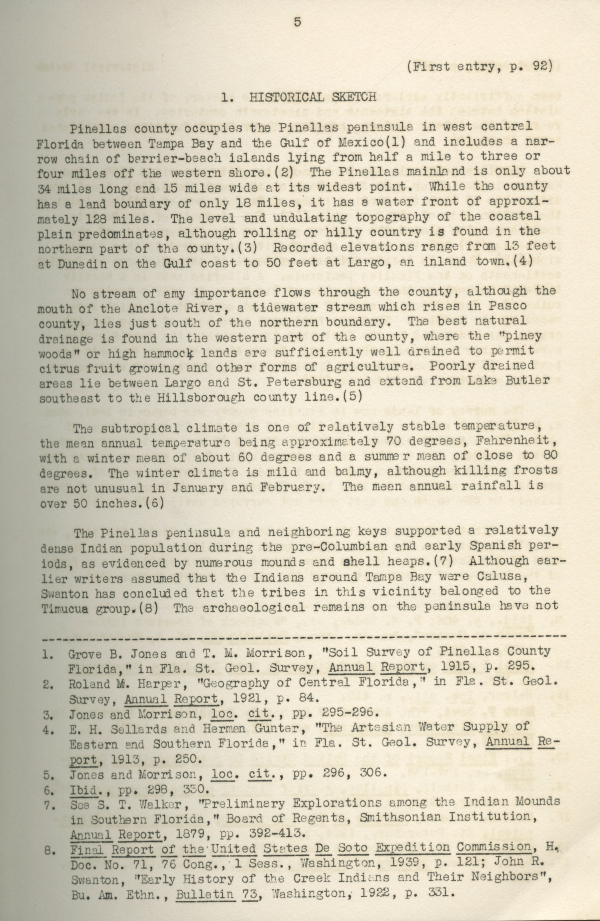


 Listen: The Folk Program
Listen: The Folk Program